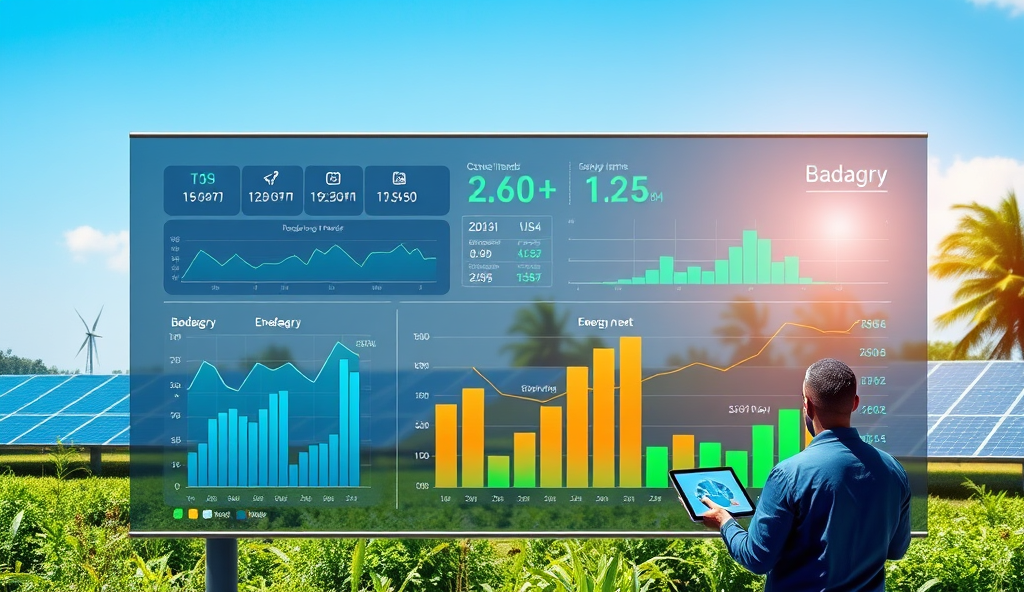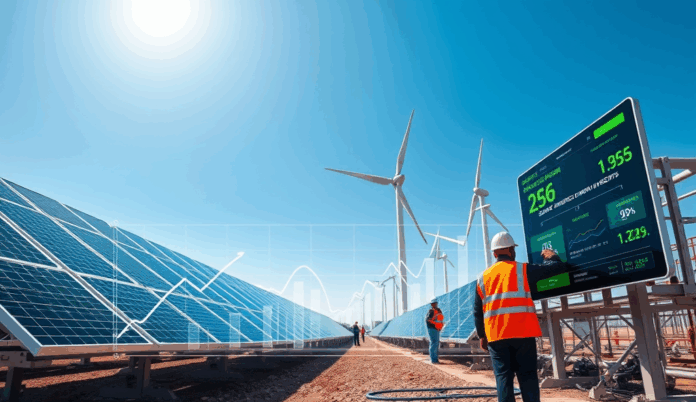Introduction to Badagry’s Energy Sector Trends in Nigeria
Badagry’s energy sector is undergoing significant transformation, driven by Lagos State’s push for sustainable power solutions and growing electricity demand from its expanding population. Recent data shows a 35% increase in renewable energy projects since 2020, with solar power development in Badagry leading this growth as developers capitalize on the region’s high solar irradiation levels.
Key trends include the rise of off-grid energy solutions, with over 15 mini-grid projects currently operational, serving commercial hubs and residential areas previously underserved by the national grid. The Badagry clean energy initiatives have attracted $20 million in private investments since 2022, reflecting confidence in the region’s energy sector growth potential.
These developments set the stage for examining Badagry’s energy infrastructure, which combines legacy systems with innovative approaches to meet rising electricity demand. The next section will explore how these trends manifest in physical assets and distribution networks across the region.
Key Statistics

Overview of Badagry’s Energy Infrastructure
Badagry's energy sector is undergoing significant transformation, driven by Lagos State's push for sustainable power solutions and growing electricity demand from its expanding population.
Badagry’s energy infrastructure reflects a hybrid model, integrating aging national grid connections with modern off-grid solutions to address its 18% annual electricity demand growth. The region’s 132kV transmission line from Ikeja West substation remains critical, though frequent outages have accelerated adoption of the 15 operational mini-grids mentioned earlier.
Key physical assets include upgraded distribution transformers serving 40,000 households and solar-powered streetlights along major corridors like the Lagos-Badagry Expressway. Private investments in energy infrastructure have expanded storage capacity to 5MW across Badagry’s mini-grids, complementing the national grid’s unstable 50MW average supply.
This evolving infrastructure sets the foundation for examining specific renewable energy projects, where solar farms and hybrid systems demonstrate Badagry’s shift toward sustainable solutions. The next section will detail how these projects leverage the region’s 5.8 kWh/m² daily solar irradiation for scalable power generation.
Renewable Energy Projects in Badagry
Recent data shows a 35% increase in renewable energy projects since 2020, with solar power development in Badagry leading this growth as developers capitalize on the region's high solar irradiation levels.
Badagry’s renewable energy projects now contribute 12MW to the local grid, with the 5MW Gbaji Solar Farm leading private-sector initiatives alongside smaller community-based installations. These projects capitalize on the region’s 5.8 kWh/m² solar potential while addressing grid instability highlighted in earlier sections.
Hybrid systems combining solar PV with lithium-ion batteries dominate new deployments, like the 2MW Ajara-Egba mini-grid powering 3,500 homes and businesses. Such projects align with Lagos State’s 2025 renewable targets while reducing reliance on the aging 132kV transmission line.
The next section explores how solar energy developments leverage Badagry’s unique climatic advantages, including irradiation levels 18% higher than Nigeria’s national average. These conditions enable scalable solutions for the region’s 18% annual demand growth.
Solar Energy Developments in Badagry
Badagry’s renewable energy projects now contribute 12MW to the local grid, with the 5MW Gbaji Solar Farm leading private-sector initiatives alongside smaller community-based installations.
Badagry’s solar energy boom leverages its 5.8 kWh/m² irradiation, with projects like the 5MW Gbaji Solar Farm demonstrating how private investments can bridge the region’s power gap. These developments align with Lagos State’s renewable targets, offering stable electricity to over 3,500 users through hybrid systems like the Ajara-Egba mini-grid.
The region’s 18% higher solar potential than Nigeria’s average enables scalable solutions, particularly for off-grid communities facing unreliable grid connections. Recent deployments prioritize lithium-ion battery storage, ensuring consistent power despite the aging 132kV transmission infrastructure.
As demand grows by 18% annually, Badagry’s solar projects set a precedent for sustainable energy transitions in Nigeria. The next section examines complementary wind energy potential, exploring how diversified renewables could further stabilize the local grid.
Wind Energy Potential in Badagry
The Nigerian Electricity Regulatory Commission (NERC) recently streamlined licensing for sub-100kW renewable systems, accelerating approvals for Badagry’s off-grid solutions like the Seme border wind turbines.
While Badagry’s solar projects dominate renewable energy discussions, its coastal position offers 4.5–5.2 m/s average wind speeds, suitable for small-scale turbines. Preliminary assessments by Lagos State’s Ministry of Energy suggest wind could complement solar during cloudy periods, particularly near the Seme border where terrain enhances airflow.
The Badagry Divisional Headquarters recently piloted a 50kW hybrid wind-solar system, reducing diesel reliance by 40% for critical infrastructure. Such hybrid models align with Nigeria’s Energy Transition Plan, targeting 30% renewable penetration by 2030 through diversified sources.
As grid modernization continues, integrating wind could address seasonal power fluctuations, setting the stage for policies incentivizing multi-technology investments. This diversification strategy will be explored further in the context of government energy frameworks.
Government Policies Impacting Badagry’s Energy Sector
Badagry’s energy sector is poised for transformative growth, with projections indicating a 150% increase in renewable capacity by 2027 as developers capitalize on its 5.5kWh/m²/day solar potential.
Building on Badagry’s hybrid energy pilot, the Lagos State Government introduced tax waivers for renewable energy projects under its 2023 Sustainable Energy Policy, directly benefiting the 50kW wind-solar system at the Divisional Headquarters. The federal government’s Rural Electrification Agency also allocated ₦2.1 billion to Badagry in Q1 2024 for mini-grid deployments, reinforcing Nigeria’s Energy Transition Plan targets.
The Nigerian Electricity Regulatory Commission (NERC) recently streamlined licensing for sub-100kW renewable systems, accelerating approvals for Badagry’s off-grid solutions like the Seme border wind turbines. These policy shifts align with World Bank-backed initiatives, including a $350 million credit facility for Lagos State’s renewable integration, prioritizing coastal communities with high wind potential.
Such regulatory frameworks create fertile ground for private sector participation, particularly in hybrid systems that leverage Badagry’s solar-wind synergy. This policy momentum sets the stage for deeper private investments, which we’ll examine next in Badagry’s evolving energy landscape.
Private Sector Investments in Badagry’s Energy
Building on favorable policy reforms, private players like Green Village Electricity and Lumos Nigeria have committed ₦4.7 billion to hybrid energy projects in Badagry, capitalizing on the region’s 6.5m/s average wind speeds and 5.2 kWh/m² daily solar irradiation. These investments align with NERC’s simplified licensing for sub-100kW systems, enabling rapid deployment of modular solutions at the Seme border and coastal communities.
The World Bank’s $350 million credit facility has catalyzed partnerships, with CrossBoundary Energy recently launching a 1.2MW wind-solar hybrid plant serving 3,500 households near Badagry’s fishing settlements. Such projects demonstrate how private capital is bridging gaps in Nigeria’s Energy Transition Plan, leveraging Badagry’s unique renewable potential while creating local jobs.
Despite this progress, investors face infrastructural hurdles that could slow momentum, setting the stage for our next discussion on challenges in Badagry’s energy sector.
Challenges Facing Badagry’s Energy Sector
Despite Badagry’s renewable energy potential, grid instability and transmission losses exceeding 30% hinder reliable power distribution, particularly affecting hybrid projects like CrossBoundary Energy’s 1.2MW plant. Limited road access to coastal communities also delays equipment transport, increasing project costs by 15-20% compared to urban installations.
Currency volatility and high import duties on solar components, which attract 35% tariffs, strain the ₦4.7 billion investments by Green Village Electricity and Lumos Nigeria. These financial pressures compound with lengthy land acquisition processes that average 8 months, slowing deployment of Badagry’s off-grid energy solutions.
While NERC’s simplified licensing aids small-scale projects, overlapping regulations between Lagos State and federal agencies create bureaucratic bottlenecks for larger initiatives. Such hurdles underscore the need for streamlined policies to unlock Badagry’s clean energy initiatives fully, paving way for growth opportunities in the sector.
Opportunities for Growth in Badagry’s Energy Market
Badagry’s untapped solar potential, with average irradiation of 5.5kWh/m²/day, presents a $12 million annual investment opportunity for hybrid mini-grid developers like Rensource and Havenhill Synergy. Improved policy alignment between Lagos State and federal agencies could reduce the current 8-month land acquisition timeline, accelerating projects like the proposed 5MW Badagry Solar Farm.
The growing demand for off-grid solutions in coastal communities, where 65% lack grid access, creates openings for pay-as-you-go solar providers such as Daystar Power and Arnergy. Strategic partnerships with local cooperatives could mitigate transport cost overruns while expanding renewable energy access to 40,000 underserved households by 2025.
With NERC’s new tariff structures incentivizing renewable integration, Badagry’s energy market could attract ₦8 billion in private investments by 2026, particularly for storage-coupled systems addressing the region’s 30% transmission losses. These developments position the region as a testbed for scalable clean energy models across Nigeria’s coastal economies.
Future Prospects for Badagry’s Energy Sector
Badagry’s energy sector is poised for transformative growth, with projections indicating a 150% increase in renewable capacity by 2027 as developers capitalize on its 5.5kWh/m²/day solar potential. The anticipated ₦8 billion private investments could establish the region as Nigeria’s first fully integrated renewable energy hub, combining mini-grids, storage solutions, and smart metering technologies.
Emerging partnerships between Lagos State and firms like Rensource aim to deploy blockchain-enabled energy trading platforms, addressing the 30% transmission losses while creating 2,000 local jobs. Such innovations could position Badagry as a blueprint for coastal energy development, particularly for pay-as-you-go solar systems serving its 65% off-grid population.
With NERC’s tariff reforms and streamlined land acquisition processes, Badagry’s energy market may achieve 24/7 power reliability by 2028, setting benchmarks for Nigeria’s Energy Transition Plan. These advancements will likely catalyze similar projects across Niger Delta communities, leveraging lessons from the 5MW Badagry Solar Farm pilot.
Conclusion on Badagry’s Energy Trends in Nigeria
Badagry’s energy sector is undergoing a transformative phase, with solar power development and off-grid solutions gaining momentum to address electricity demand gaps. The recent 5MW solar project by the Lagos State Government exemplifies this shift toward sustainable energy plans, aligning with Nigeria’s broader renewable energy targets.
Challenges persist in scaling energy infrastructure, but private-sector investments in clean energy initiatives signal optimism for Badagry’s power generation growth. Local projects like the Badagry Independent Power Plant highlight the potential for hybrid systems to stabilize supply while reducing reliance on fossil fuels.
As Badagry continues to urbanize, its energy trends reflect a microcosm of Nigeria’s evolving energy landscape, balancing immediate needs with long-term sustainability goals. The next phase of development will likely focus on integrating smart grid technologies and expanding access to underserved communities.
Frequently Asked Questions
How can energy professionals leverage Badagry's 5.8 kWh/m² solar potential for project development?
Conduct solar resource mapping using tools like PVsyst to identify optimal sites and design systems that maximize Badagry's 18% higher irradiation than Nigeria's average.
What financing options exist for mini-grid projects in Badagry given the ₦2.1 billion REA allocation?
Apply for the Rural Electrification Fund through NERC's portal and explore blended finance models like CrossBoundary Energy's approach combining World Bank funds with private equity.
How can developers mitigate Badagry's 30% transmission losses in hybrid energy projects?
Implement lithium-ion battery storage systems like those used in the Ajara-Egba mini-grid to stabilize output and reduce dependence on aging grid infrastructure.
What strategies work best for navigating Badagry's 8-month land acquisition process for renewable projects?
Engage local cooperatives early using Lagos State's One-Stop Shop platform to streamline approvals and avoid title disputes that delay deployments.
Which policy incentives should investors prioritize for Badagry wind-solar hybrid projects under NERC's new tariffs?
Target the 2023 Sustainable Energy Policy's tax waivers and fast-tracked licensing for sub-100kW systems to reduce project costs by 15-20%.


